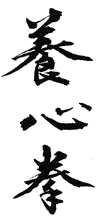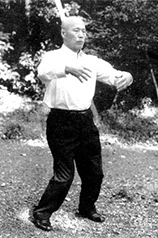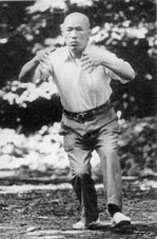| |
TAIKI-SHISEI-KENPO = TAIKIKEN
Taikiken is a Japanese martial art form founded by Soshi Kenichi Sawai (1903-1988), see above pict. This system is based upon Chinese hand to hand combat form
known as”Chuan-fa ”or ”Kempo” ( Japanese ), within the internal system
known as ”Nei Jia” consisting of:
1. Tai chi 2. Hsing I 3. Ba Gua.
Sawai sensei was especially impressed by Grand Master Wang Xiangzhai (1885-1963) who was one of the most famous Wushu
specialists of his time. Wang Xiangzhai´s system Yiquan was also known as
Dachengquan and related to Hsing I. During Sawai sensei´s military service in China
from 1932, he met Wang Xiangzhai in hand to hand combat, and even with Sawai
sensei´s considerable expertise in
Japanese budo – 5th Dan Judo, 4th Dan Kendo, 4th Dan Iaido, at 22 years
of age, he was totally defeated, resulting in complete dedication to
Yiquan way of training.
When returning to Japan, Sawai sensei´s training continued alone
and in 1947 with Grand master Wang´s blessing he started his
Taikiken school. Training was held at a special place in Tokyo at
Meiji-Jingu, outside close to nature, surounded by trees.
Taikiken attracted many budoka, particularly from Kyokushinkai Karatedo, since
Sawai sensei had a long relationship with Masutatsu Oyama going
back to his university days in judo. The Taikiken from Sawai sensei was
unique in many ways, he never opened a headquarter training hall (
Honbu dojo ), training was held outside as often as possible, he taught
at his senior students dojo´s, and he wore normal clothes for
training. If it rained, everyone met at a coffee shop for discussion,
his knowledge seemed to be unlimited, just like his own personal
development, he just seemed to get better.
His training could go on for many hours, very few would leave, all
being anxious not to miss even the smallest detail. Amongst his senior
Japanese students were his son Akio
Sawai, his son-in-law Yoshimichi Sato, Norimasa Iwama, Kazuo Yoshida,
Yukio Ito, Mikio Goto, Hatsuo Royama, Masashi Saito.
|
|
Here in Europe the group who
have been direct students to Sawai
Sensei, is not so big: Kyoshi Jan Kallenbach from Holland and leader for
Taikiken in Europe, Jean-Luc Lesueur (France), and Marshall McDonagh
(Sweden). Ron
Nansink and Wiert Postema (Holland)
Sawai sensei was a living example of what can be achieved through the
discipline of the budo from Japan and the Yiquan from Nei-jia in China,
and he lived a long life filled with much danger and hardships, yet he
enjoyed good health, and was very active up until his death in 1988.
His inspiration and encouragement has led to the contact between Taikiken and Yiquan, from Japan in
particular Mr.Kubo Isato through his co-operation and study with Yao Chengguang (son to Master Yao Xongzun,
”brother boxer” to Sawai sensei when both trained with Grandmaster Wang
Xiangzhai )
Marshall McDonagh and later Jan Kallenbach met and trained with Master Cui Rui Bin and Master Dao Si Ming in
Beijing the first europeans to make contact with the the Yiquan as
trained by the direct disciple Yao Xongzun to Master Wang Xiangzhai,
these masters being the main source of inspiration of Yiquan to Sawai
sensei, so the circle was completed for both Marshall and Jan sensei –
Starting with Kyokushinkai (Sosai Mas
Oyama) to Taikiken (Soshi Kenichi Sawai) to Yiquan (Master Cui Rui Bin
–Master Dao Siming – Master Li Jian Yu).
Today in Japan Kyoshi Yoshimichi Sato is still very active with Taikiken following very
closely the teachings of Sawai sensei as is Kyoshi Norimasa Iwama,
these two being the main source for the spreading interest for Taikiken
in Japan along with Mr.Takagi
Yasuhide, Mr. Seiji Sato and Mr Michio Shimada.
|




